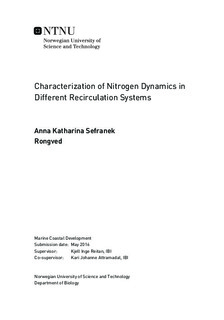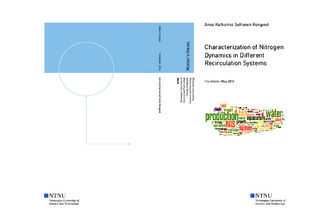| dc.description.abstract | The need to reduce freshwater consumption in global food production has long been recognized. Food production in single- and multi-species recirculation systems offers advantages in terms of reduced water and energy consumption, in addition to improved opportunities for waste management and nutrient recycling. In aquaculture, land-based recirculation systems treat the water for waste products, and some is released as wastewater. The wastewater contains a great amount of nitrogen (N), and represents an unutilized resource with potential for further use as fertilizer in plants and microalgae production. Nitrogen is a fundamental element in both animal and plant cells. It is a key component in protein-rich fish feed, it is the nutrient required in largest amounts by plants, and a main element in microalgae fertilizers.
This thesis describes nitrogen dynamics in different bio-producing recirculation systems: A recirculating aquaculture system (RAS) producing Atlantic salmon (Salmo salar), a hydroponic system producing strawberries (Fragaria x ananassa Elan ), an aquaponic system with integrated trout (Oncorhynchus mykiss and Salmo trutta) and lettuce (Lactuca sativa) production, and a pilot system with combined copepod (Acartia tonsa) and microalgae (Rhodomonas baltica) production (Copeponics). Possibilities for increased system performances, in terms of sustainable use of water and nitrogen, were investigated.Implementation of integrated or end of pipe bio-producing treatments is suggested as a sustainable wastewater treatment strategy in the RAS. An ongoing and unidentified in-tank removal of ca. 24.0% NO3-N was discovered. Phototrophic nitrate removal by microalgae cells and other microorganisms in biofilm is expected. In the Hydroponic system, elevated NO3- concentrations (429-566 mg L-1) to commercial hydroponic nutrient solutions (49-210 mg L-1) were detected. L. sativa in the Aquaponic system removed dissolved nitrogen inefficiently: ca. 26% removal of TAN and only ca. 5% removal of NO3-N. Copeponics showed very good copepod egg production and normal microalgae production. Compared with production in standard flow through systems, internal recirculation reduced the total water consumption (10%/day), and the lowered energy and microalgae need. Microalgae was cultivated with copepod wastewater, and additional fertilizer use in the microalgae production was on average reduced with ca. 42% compared to standard production. The recirculation system allowed for storing of the microalgae cells in the system, and microalgae consumption in the copepod production in Copeponics was on reduced with ca. 15% compared with standard flow through production. | |

